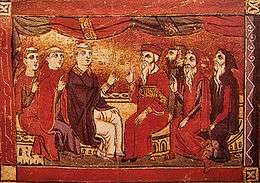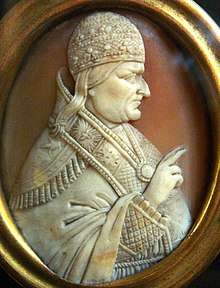Isa Kelemechi

Isa Tarsah Kelemechi (Mongolian: Isa Khelmerchi (Isa the Interpreter); Chinese: Ai-hsüeh) was an Assyrian[1] Nestorian Christian scientist, and official at the Yuan court of Kublai Khan's Mongol Empire in the 13th century.[2]
Astrologer in China
Isa Kelemechi was named head of the "Office of Western Astronomy" established by the Mongol ruler Kubilai Khan in 1263 to study Muslim astronomical observations.[3] Kubilai would establish a second Observatory for Islamic astronomy in 1271, directed by astronomer Jamal al-Din.[3]
Isa Kelemechi was also instrumental in reinforcing anti-Muslim prohibitions in the Mongol realms, such as prohibiting halal slaughter and circumcision, and, according to Rashid al-Din encouraged denunciation of Muslims.[4] Isa Kelemechi also showed to Khubilai the Muslim precept of "Kill the polytheists, all of them", raising the suspicion of the Mongols towards Muslims.[4] According to Rashid al-Din, as a result "most Muslims left Khitai".[4]
Diplomat to Europe

Isa Kelemechi was later a member of the first mission to Europe sent by the Mongol Il-Khan ruler Arghun in 1285. He met with Pope Honorius IV, remitting a letter from Ghazan offering to "remove" the Saracens and divide "the land of Sham, namely Egypt" with the Franks.[5][6] The message, written in imperfect Latin, said:
"And now let it be [says the Il-Khan], because the land of the Saracens is not ours, between us, good father, us who are on this side and you who are on your side; the land of Scami [Sham] to wit the land of Egypt between you and us we will crush. We send you the said messengers and [ask] you to send an expedition and army to the land of Egypt, and it shall be now that we from this side shall crush it between us with good men; and that you send us by a good man where you wish the aforesaid done. The Saracens from the midst of us we shall lift and the Lord Pope and the Cam [Great Khan Qubilai] will be lords".
— Message from Arghun to Pope Honorius IV.[6]
The 1285 embassy would be followed in 1287 by that of Rabban bar Sauma.[5]
See also
Notes
- ↑ Atwood.C.P., (2005) - EOMAM
- ↑ Foltz, Richard, Religions of the Silk Road, Palgrave Macmillan, 2nd edition, 2010 ISBN 978-0-230-62125-1, pp. 125–126
- 1 2 Thomas F. Glick; Steven John Livesey; Faith Wallis (2005). Medieval science, technology, and medicine: an encyclopedia p.485. Routledge. ISBN 0-415-96930-1.
- 1 2 3 Richard Foltz (2000). Religions of the Silk Road: Overland Trade and Cultural Exchange p.125ff. Palgrave Macmillan. ISBN 0-312-23338-8.
- 1 2 Peter Jackson (2005). The Mongols and the West, 1221-1410 p.169. Pearson Education. ISBN 0-582-36896-0.
- 1 2 William Bayne Fisher; John Andrew Boyle (1968). The Cambridge history of Iran p.370. Cambridge University Press. ISBN 0-521-06936-X.